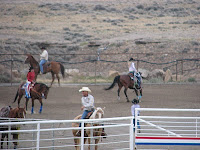 What component draws a reader to westerns? Today's post is dedicated to writers of the "western" genre. But don't run away if that isn't your cup of tea! Westerns have ingredients that need to be found in other genres as well.
What component draws a reader to westerns? Today's post is dedicated to writers of the "western" genre. But don't run away if that isn't your cup of tea! Westerns have ingredients that need to be found in other genres as well.This last weekend I went to a rodeo in Cody, Wyoming. It was the first real rodeo I've attended. During the show, I noticed many interesting ideas that could be infused into any story line. Here is what I saw:
1. The care taken by cowboys and cowgirls to protect the safety of others. (group members demonstrating how they care for others in their group)
 2. The care taken by cowboys and cowgirls to protect the safety of the animals. (individuals demonstrating how they care for animals)
2. The care taken by cowboys and cowgirls to protect the safety of the animals. (individuals demonstrating how they care for animals)3. The persistence by cowboys and cowgirls to get back on their horse after falling. (refusing to let a tragedy or problem keep you down.
4. The teaching spirit to raise a new generation of cowboys and cowgirls. (older teaching younger the ways of live
5. The support of a western town for the cowboys and cowgirls in the arena. (community cheering for their own, supporting their own, helping their own)
To ask audience members what they liked about westerns, I may not get a direct answer. Maybe they didn't really know what captivated their attention other than to say they liked the thrill of seeing the good guy win in the end. After considering what I'd seen, read, and knew, I came up with a theory regarding the necessary components of a character in a western.
 Dedicated: To be a cowboy or cowgirl, one must dedicate their time to training and caring for their animal. Cowboys and Cowgirls practiced off to the side during the show until their time to perform.
Dedicated: To be a cowboy or cowgirl, one must dedicate their time to training and caring for their animal. Cowboys and Cowgirls practiced off to the side during the show until their time to perform.Persistent: They must be persistent to try again and again. At the rodeo, one cowboy's arm became tangled while riding a horse in the arena. When the horse bucked him off, he flopped up and down, hooked to the saddle and couldn't fall safely away. A swarm of cowboys came in to help set him free. It sure looked like he'd be heading to the hospital, but later in the show, he competed in the calf roping.
Audiences enjoy the dynamic rescues and the down-home life style of westerns. The Lone Ranger demonstrates taking necessary risks to fight for the good, Bonanza shows taking necessary risks to fight for the family ranch, other western stories reflect an unquenching drive to survive in an untamed land, and townfolks who band together to get rid of the bad guy. These and other components found in westerns are components readers want for themselves and can be included in any genre.
Once upon a time, explorers and pilgrims headed west to populate a new land. Years later explorers, settlers, and gold diggers populated another west. What is your west in terms of your writing? Have you allowed yourself to explore fresh new ways to tell your story? Do you characters draw people to your story with their dedication, brother/sisterhood, and persistence?





















2 comments:
Great post, Mary! I loved the parrells that you put in. Love the photos too. :)
Thanks for stoppy by, Casey:)
Post a Comment